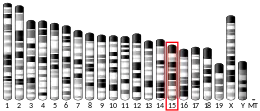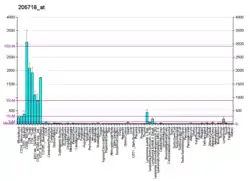Integrin beta 7
Integrin beta-7 is an integrin protein that in humans is encoded by the ITGB7 gene.[5][6] It can pair with ITGA4 (CD49d) to form the heterodimeric integrin receptor α4β7, or with ITGAE (CD103) to form αEβ7.[7]
Structure
Like all integrin subunits, β7 is a highly flexible, membrane-bound, extracellular protein that must pair with an α subunit for stability. The molecule's flexibility allows it to dynamically regulate its affinity for ligand through conformational changes.[8] Beginning with the apical end of the protein, farthest from the cell membrane, the β7 is composed of a head and upper legs, collectively known as the headpiece, lower legs, a transmembrane domain and a cytoplasmic tail. The top of the head is the I-like domain, sometimes called the βI domain, which, in combination with the α subunit, binds ligand. Just below this is the hybrid domain, a portion of which is N-terminal to the I-like domain. Below the hybrid domain is the PSI domain, which completes the headpiece. The lower legs consist of EGF domains 1-4 and the β tail domain. Finally there is a transmembrane domain, and the C-terminal cytoplasmic tail.[9]
References
- GRCh38: Ensembl release 89: ENSG00000139626 - Ensembl, May 2017
- GRCm38: Ensembl release 89: ENSMUSG00000001281 - Ensembl, May 2017
- "Human PubMed Reference:". National Center for Biotechnology Information, U.S. National Library of Medicine.
- "Mouse PubMed Reference:". National Center for Biotechnology Information, U.S. National Library of Medicine.
- Erle DJ, Rüegg C, Sheppard D, Pytela R (Jun 1991). "Complete amino acid sequence of an integrin beta subunit (beta 7) identified in leukocytes". The Journal of Biological Chemistry. 266 (17): 11009–16. PMID 2040616.
- "Entrez Gene: ITGB7 integrin, beta 7".
- Byron A, Humphries JD, Askari JA, Craig SE, Mould AP, Humphries MJ (Nov 2009). "Anti-integrin monoclonal antibodies". Journal of Cell Science. 122 (Pt 22): 4009–11. doi:10.1242/jcs.056770. PMC 3329622. PMID 19910492.
- Carman CV, Springer TA (Oct 2003). "Integrin avidity regulation: are changes in affinity and conformation underemphasized?". Current Opinion in Cell Biology. 15 (5): 547–56. doi:10.1016/j.ceb.2003.08.003. PMID 14519389.
- Yu Y, Zhu J, Mi LZ, Walz T, Sun H, Chen J, Springer TA (Jan 2012). "Structural specializations of α(4)β(7), an integrin that mediates rolling adhesion". The Journal of Cell Biology. 196 (1): 131–46. doi:10.1083/jcb.201110023. PMC 3255974. PMID 22232704.
- Rietzler M, Bittner M, Kolanus W, Schuster A, Holzmann B (Oct 1998). "The human WD repeat protein WAIT-1 specifically interacts with the cytoplasmic tails of beta7-integrins". The Journal of Biological Chemistry. 273 (42): 27459–66. doi:10.1074/jbc.273.42.27459. PMID 9765275.
Further reading
- Rüegg C, Postigo AA, Sikorski EE, Butcher EC, Pytela R, Erle DJ (Apr 1992). "Role of integrin alpha 4 beta 7/alpha 4 beta P in lymphocyte adherence to fibronectin and VCAM-1 and in homotypic cell clustering". The Journal of Cell Biology. 117 (1): 179–89. doi:10.1083/jcb.117.1.179. PMC 2289398. PMID 1372909.
- Chan BM, Elices MJ, Murphy E, Hemler ME (Apr 1992). "Adhesion to vascular cell adhesion molecule 1 and fibronectin. Comparison of alpha 4 beta 1 (VLA-4) and alpha 4 beta 7 on the human B cell line JY". The Journal of Biological Chemistry. 267 (12): 8366–70. PMID 1373725.
- Jiang WM, Jenkins D, Yuan Q, Leung E, Choo KH, Watson JD, Krissansen GW (Sep 1992). "The gene organization of the human beta 7 subunit, the common beta subunit of the leukocyte integrins HML-1 and LPAM-1". International Immunology. 4 (9): 1031–40. doi:10.1093/intimm/4.9.1031. PMID 1382574.
- Baker E, Sutherland GR, Jiang WM, Yuan Q, Leung E, Watson JD, Krissansen GW (1992). "Mapping of the human integrin beta 7 gene (ITG beta 7) to 12q13.13 by non-isotopic in situ hybridization". Mammalian Genome. 2 (4): 272–3. doi:10.1007/BF00355438. PMID 1543919. S2CID 30346801.
- Yuan QA, Jiang WM, Krissansen GW, Watson JD (Dec 1991). "Cloning and sequence analysis of a novel beta 2-related integrin transcript from T lymphocytes: homology of integrin cysteine-rich repeats to domain III of laminin B chains". International Immunology. 3 (12): 1373–4. doi:10.1093/intimm/3.12.1373. PMID 1777426.
- Yuan QA, Jiang WM, Krissansen GW, Watson JD (1991). "Cloning and sequence analysis of a novel beta 2-related integrin transcript from T lymphocytes: homology of integrin cysteine-rich repeats to domain III of laminin B chains". International Immunology. 2 (11): 1097–108. doi:10.1093/intimm/2.11.1097. PMID 2083230.
- Erle DJ, Brown T, Christian D, Aris R (Mar 1994). "Lung epithelial lining fluid T cell subsets defined by distinct patterns of beta 7 and beta 1 integrin expression". American Journal of Respiratory Cell and Molecular Biology. 10 (3): 237–44. doi:10.1165/ajrcmb.10.3.7509610. PMID 7509610.
- Postigo AA, Sánchez-Mateos P, Lazarovits AI, Sánchez-Madrid F, de Landázuri MO (Sep 1993). "Alpha 4 beta 7 integrin mediates B cell binding to fibronectin and vascular cell adhesion molecule-1. Expression and function of alpha 4 integrins on human B lymphocytes". Journal of Immunology. 151 (5): 2471–83. PMID 7689608.
- Shaw SK, Cepek KL, Murphy EA, Russell GJ, Brenner MB, Parker CM (Feb 1994). "Molecular cloning of the human mucosal lymphocyte integrin alpha E subunit. Unusual structure and restricted RNA distribution". The Journal of Biological Chemistry. 269 (8): 6016–25. PMID 8119947.
- Tidswell M, Pachynski R, Wu SW, Qiu SQ, Dunham E, Cochran N, Briskin MJ, Kilshaw PJ, Lazarovits AI, Andrew DP, Butcher EC, Yednock TA, Erle DJ (Aug 1997). "Structure-function analysis of the integrin beta 7 subunit: identification of domains involved in adhesion to MAdCAM-1". Journal of Immunology. 159 (3): 1497–505. PMID 9233649.
- Tan K, Casasnovas JM, Liu JH, Briskin MJ, Springer TA, Wang JH (Jun 1998). "The structure of immunoglobulin superfamily domains 1 and 2 of MAdCAM-1 reveals novel features important for integrin recognition". Structure. 6 (6): 793–801. doi:10.1016/S0969-2126(98)00080-X. PMID 9655832.
- Rietzler M, Bittner M, Kolanus W, Schuster A, Holzmann B (Oct 1998). "The human WD repeat protein WAIT-1 specifically interacts with the cytoplasmic tails of beta7-integrins". The Journal of Biological Chemistry. 273 (42): 27459–66. doi:10.1074/jbc.273.42.27459. PMID 9765275.
- Taraszka KS, Higgins JM, Tan K, Mandelbrot DA, Wang JH, Brenner MB (May 2000). "Molecular basis for leukocyte integrin alpha(E)beta(7) adhesion to epithelial (E)-cadherin". The Journal of Experimental Medicine. 191 (9): 1555–67. doi:10.1084/jem.191.9.1555. PMC 2213439. PMID 10790430.
- Higgins JM, Cernadas M, Tan K, Irie A, Wang J, Takada Y, Brenner MB (Aug 2000). "The role of alpha and beta chains in ligand recognition by beta 7 integrins". The Journal of Biological Chemistry. 275 (33): 25652–64. doi:10.1074/jbc.M001228200. PMID 10837471.
- Puig-Kröger A, Sanz-Rodríguez F, Longo N, Sánchez-Mateos P, Botella L, Teixidó J, Bernabéu C, Corbí AL (Oct 2000). "Maturation-dependent expression and function of the CD49d integrin on monocyte-derived human dendritic cells". Journal of Immunology. 165 (8): 4338–45. doi:10.4049/jimmunol.165.8.4338. PMID 11035069.
- Guilliano MJ, Foxx-Orenstein AE, Lebman DA (Feb 2001). "The microenvironment of human Peyer's patches inhibits the increase in CD38 expression associated with the germinal center reaction". Journal of Immunology. 166 (4): 2179–85. doi:10.4049/jimmunol.166.4.2179. PMID 11160270.
- Calderwood DA, Huttenlocher A, Kiosses WB, Rose DM, Woodside DG, Schwartz MA, Ginsberg MH (Dec 2001). "Increased filamin binding to beta-integrin cytoplasmic domains inhibits cell migration". Nature Cell Biology. 3 (12): 1060–8. doi:10.1038/ncb1201-1060. PMID 11781567. S2CID 6459957.
- Calderwood DA, Fujioka Y, de Pereda JM, García-Alvarez B, Nakamoto T, Margolis B, McGlade CJ, Liddington RC, Ginsberg MH (Mar 2003). "Integrin beta cytoplasmic domain interactions with phosphotyrosine-binding domains: a structural prototype for diversity in integrin signaling". Proceedings of the National Academy of Sciences of the United States of America. 100 (5): 2272–7. doi:10.1073/pnas.262791999. PMC 151330. PMID 12606711.
External links
- ITGB7 Info with links in the Cell Migration Gateway






